Professional floral arrangements look so beautiful it’s easy to disregard the skill and knowledge that goes into their creation. However, don’t let that discourage you from taking up flower arranging yourself. This is a wonderful skill to have whether you want to make arrangements for yourself or sell them.
Anyone can begin making beautiful arrangements once they understand the basics of floral design. Follow our guide to learn the foundational steps to flower arranging, from creating a design to gathering supplies and, finally, putting everything together. You’ll soon be making professional-looking floral displays!
Three Basic Steps for How to Make Floral Arrangements
Creating floral arrangements is a simple process that can be broken down into three basic steps:
- Conceptualize your design: Whether you have a mental image, a sketch, or follow a photo for inspiration, you should have a basic idea of what you want.
- Gather your supplies and materials: Get everything you need before you start. That includes flowers and greenery, florist supplies, and tools.
- Make the arrangement: Now you can get to work! Start placing and arranging stems until you’re happy with what you’ve made.
Of course, each of these steps has smaller steps within them. Continue reading this guide to learn more about mastering these floral design basics. With these tips and some practice, you’ll soon feel confident in your flower-arranging skills!
Designing Your Floral Arrangement
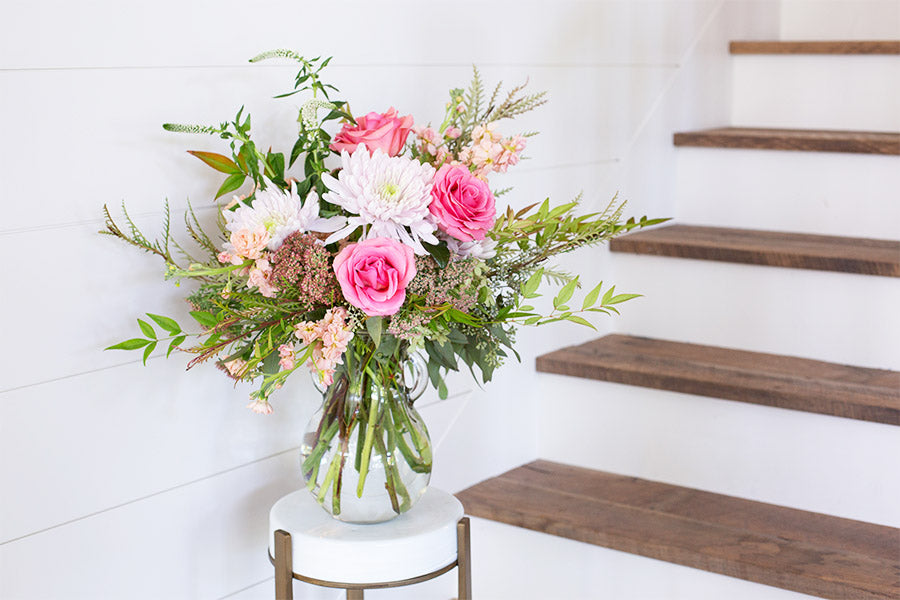
When designing your arrangement, consider things like the final shape, flower colors, and textures.
Your floral design should start with a purpose. What do you need the arrangement for? What kind will it be? A bridal bouquet, a dining table centerpiece, or something pretty for your home?
Now, consider the details of your floral design. As you conceptualize your arrangement, consider these basic floral design principles:
- Shape: You can cut and arrange flowers to achieve different shapes, such as round, square, triangle, diamond, crescent, or asymmetrical.
- Balance: Balance large blossoms with another large blossom or cluster of smaller flowers. Distribute greenery evenly. Avoid gaps or densely packed areas.
- Space: Consider flower distribution. Do you want a full or sparse arrangement? Loose or densely packed?
- Size: How big or small should the arrangement be? You’ll want to make a centerpiece fit the table it will go on and a bride’s bouquet comfortable to carry but still eye-catching.
- Lines: Pay attention to the natural lines of leaves and stems in your arrangement. Create lines with patterns of similar flowers.
- Color: Decide on your color palette before choosing flowers. Use complimentary, contrasting, or monochromatic hues depending on your desired look.
- Texture: Do you want a stiff, formal arrangement or something soft and wispy? This decision will guide you to the right botanicals.
- Contrast: Use opposites to create interesting contrast: small and big flowers, bold and soft colors, smooth and feathery textures. Or, don’t and keep things sleek and simple.
- Focal point: You can create a dramatic focal point in your arrangement with a contrasting element like a larger flower or one of a different color. This approach helps attract the eye and gives it a place to start exploring your creation.
- Rhythm: Rhythm in this context refers to how your design helps move the eye through your design. Create rhythm and pull the eye to all parts of your arrangement by repeating colors, textures, and lines–but also throw in some surprises!
Must-have Florist Tools and Supplies
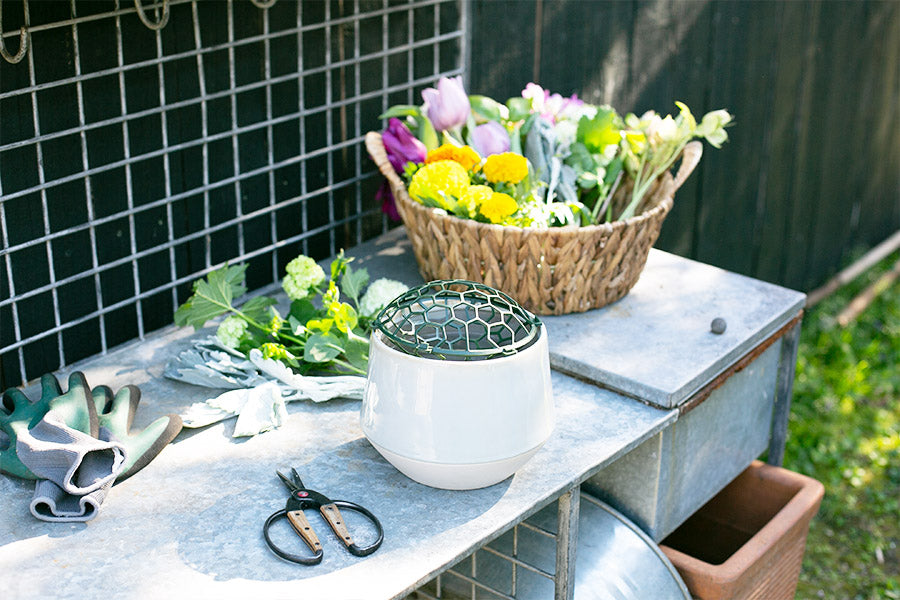
You need more than flowers to create a stunning floral arrangement. You need tools to prep the flowers and supplies to hold them in place to build your desired shape. You’ll find lots of these items on the market, but don’t get overwhelmed. Here’s a short list of must-have tools for basic floral design:
- Floral clippers for trimming stems and unwanted leaves.
- Thin gardening gloves that protect your hands but still give you a good grip.
- Floral tape to create a grid for supporting stems in a container or bind stems together for a bouquet.
- Floral mechanics. These handy, reusable tools provide a solid base to insert flowers into and hold them securely.
- Floral foam can provide a base to hold flowers in place as well as hold water to keep blooms hydrated.
- Floral wire for wrapping stems together.
- Water tubes for hydrating stems that don’t have access to water otherwise.
- Vase or similar container to hold your arrangement and water.
- Flower food to help flowers stay fresh longer.
Choosing Flowers for Basic Floral Design
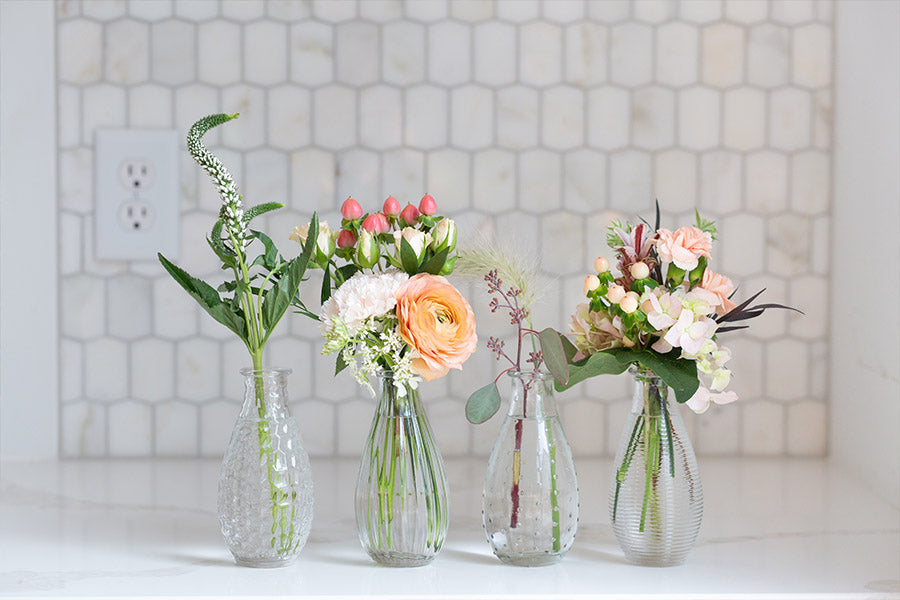
Different kinds of flowers serve different purposes in your arrangement, so make your picks accordingly.
You can use just about any flower or greenery with long stems for floral arrangements. There are too many possibilities to list here, but consider these flower categories when choosing blossoms to help you use the right variety for your design:
- Focal flowers: Large, attractive flowers that catch the eye and anchor your design.
- Filler flowers: Small flowers that add color and texture to your arrangement and make it fuller.
- Line flowers: Tall stems that help shape the arrangement, especially if you want height, and add color and texture to the outer edges.
- Detail flowers: More delicate blossoms that seemingly float over the main arrangement and give it movement.
- Greenery: Stems of green foliage to give your arrangement a foundation, helping shape it and fill in gaps.
Preparing to Arrange Your Flowers
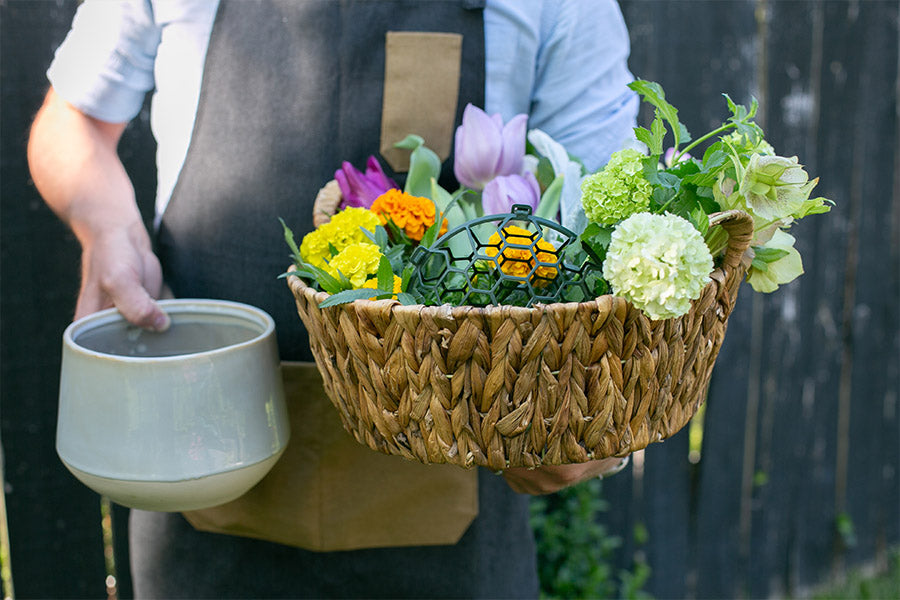
A little prep work sets you up for a beautiful floral creation.
You’ve gathered your supplies and chosen your blooms. Before you build your floral design, follow these steps to ensure everything is ready.
- Remove dead or damaged leaves and flowers. Remove thorns and leaves or buds that may fall below the water line.
- Cut all stem bottoms at an angle.
- If using a vase or container, fill it with water or soaked floral foam. Include flower food and a few drops of bleach to prevent rot.
- Put in a floral mechanic, flower grid, or tape grid to support the flowers.
How to Arrange Flowers
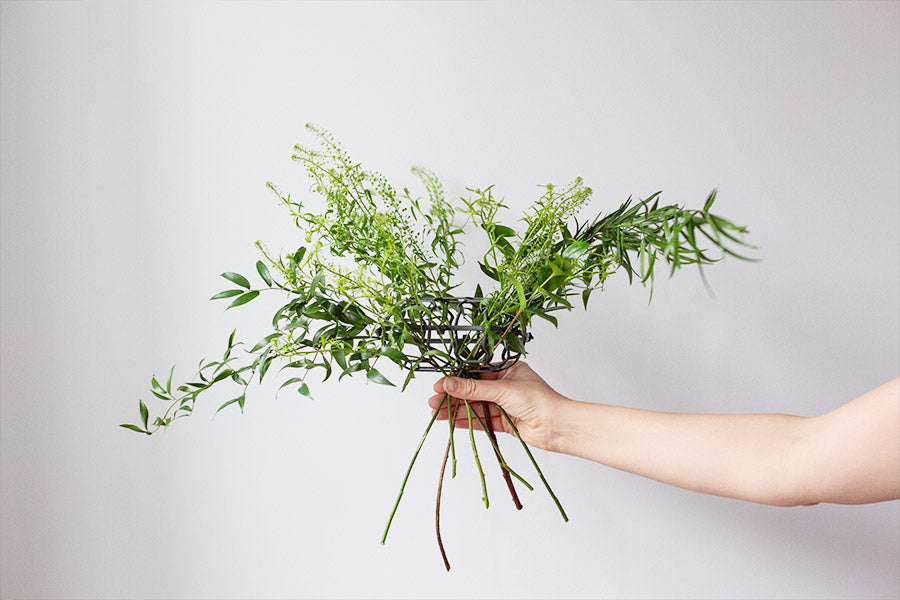
Start with fresh greenery to give your flower arrangement a base to build off of.
Arranging flowers takes more thought than dropping flowers in a vase willy-nilly. But once you understand how to arrange flowers and practice some techniques, you’ll be surprised how easily arrangements come together. Get started with these basic steps, and then you can play around and find your own style.
- Start with greenery. Trim foliage stems and arrange them in your container, hand, or floral mechanic to build a base.
- Trim and insert your focal flower(s). Most florists prefer to use an odd number of focal flowers for a natural look.
- Add line flowers to begin building the shape of your arrangement.
- Insert smaller filler flowers. Trim to different lengths and try several angles to gradually build your final arrangement shape.
- Finish off your creation with detail flowers.
- Fill in gaps with more greenery or filler flowers. Make adjustments until you’re happy with the results.
- Admire your handiwork!
When making a hand bouquet, follow the steps above, but save the greenery for last. Once your stems are arranged how you want, wrap floral wire around them to secure them. Then, wrap floral tape around the stems to hide the wire. You might also wrap decorative ribbon around the tape for a more finished look.
Flower Arranging Begins with Supplies from 46 & Spruce!
You’ll feel inspired to create your first floral arrangements when you see the innovative florist supplies from 46 & Spruce. Check out our curated collections of vases and tools of the trade. We even offer exclusive products and prices for our Professional Account holders. Have questions? Contact us anytime to learn more about 46 & Spruce.

